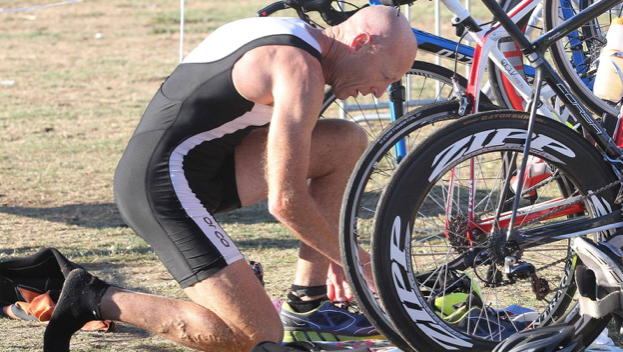A Return to Competition
I recently received an email from an old friend – Mat Brick, a former multisport pro athlete who is now a sports orthopedic surgeon in New Zealand. In his days as a pro, back in the 1980s and ‘90s, Mat was a two-time World Champion in duathlon. Now he’s making an age-group return to competition. Last January he did the Tauranga Half Ironman triathlon, his first long-distance multisport race in many years. Now in his 50s, he was still able to produce a good time for an aging athlete – 4:21:01. Good enough for a podium in his age group.

As for the race details, Mat was pleased with his bike split of 2:11 – only about 10 minutes off of his best as a pro some 30 years ago. But he was concerned about his run performance. His time was 1:36 – 26 minutes slower than his best as young pro. He’s certain his VO2max is still quite high, and his anaerobic threshold also seems to be good. So that brings the dilemma down to the third marker of endurance fitness – economy — which has to do with how much energy one expends in moving the body forward, as in running. The lower the energy expenditure at any given pace, the higher one’s fitness. The more energy one wastes at the same pace, the less fit they are. Mat’s main question to me in his email was how best to improve his running efficiency as an older athlete? He asked if he should run longer, do short intervals, do long intervals, include plyometrics, or run more steady state? The answer I gave him was “yes.” To misquote legendary cyclist Eddy Merckx, “Run lots!”
Improving Running Economy
So what does sport science say about economy? Here’s what I told Mat:
Unfortunately, there’s not as much research on running economy as there is on VO2max. What sport science tells us (along with my opinions) is that economy is enhanced by…
- Short, frequent workouts (fatigue during long runs causes athletes to engrain bad skills habits and run less economically).
My opinion: How “short” is short depends on the athlete’s level of tolerance for workout duration. When fatigue is evident, it’s time to stop, from a pure economy point of view.
- Strength training, especially hip-knee-ankle extensions (squats, step-ups, lunges, etc.), may help. There is considerable debate on whether this should be high load / low reps or low load / high reps.
My opinion: I think as long as you work to near failure on each set it doesn’t matter a whole lot, although I tend to change up the routine with the athlete’s periodization plan.
- Plyometrics have usually been shown to improve economy. Short, uphill repeats are similarly effective.
My opinion: Plyometrics are probably beneficial because they enhance a short ground contact time and mid-foot strike power (high force plus high leg turnover produces greater power; greater power means faster run times).
- Economy also appears to be pace specific. Intervals at race pace have a more positive effect than below or above race pace.
My opinion: I suspect that there is a range that applies to effective “race pace” for each of us. Spending more run time, within reason, around that pace is effective. This is where the 80/20 and my 5-2 training routine fit in.
- Limited ankle flexibility. Flexibility here appears to be contrary to economy. In other words, stiff ankles have a greater energy return (like a tight spring vs. a lax one).
My opinion: This is why I don’t promote using the “runner’s wall stretch” unless there is a tendency for injury to the posterior lower leg (Achilles, calf, etc.).
On a related note, there’s considerable research showing that athletes with high economy tend to have a relatively low VO2max. It’s rare to find a runner who has both high economy and high aerobic capacity. Many of the east African runners appear to fall into the category of high-high, which helps to explain their success.

You must be logged in to post a comment.